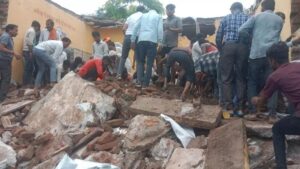Jhalawar School Tragedy: Questions of Accountability and Systemic Neglect, May Happen in Samba Distt
Samba Times Special

On July 25, 2025, a tragic incident shook Piplodi village in Rajasthan’s Jhalawar district when the roof of the Government Upper Primary School collapsed, claiming the lives of seven children and injuring 27 others, with nine in critical condition. The 35-year-old school building, reportedly in poor condition, gave way during the morning session, burying students of Classes 6 and 7 under debris. In the aftermath, five teachers, including the principal, were suspended, and a high-level inquiry was ordered. However, the incident has sparked a broader debate about accountability, systemic neglect, and the state of school infrastructure, with parallels drawn to similar concerns in many distts especially in District Samba, Jammu & Kashmir.
The Jhalawar Incident: What Happened?
The collapse occurred around 7:45 AM, just as students were gathered in a classroom, reportedly due to rain preventing the usual morning assembly outdoors. Students had noticed signs of danger—falling gravel and pebbles from the ceiling—and alerted their teachers. According to survivors, one teacher dismissed their concerns, instructing them to “sit quietly” or that “nothing will happen.” Moments later, the roof caved in, leading to devastating consequences. The victims, aged between 6 and 15, included Payal (12), Priyanka (12), Kundan (12), Harish (8), Kartik, Meena (12), and her brother Kanha (6).
Locals and parents, who rushed to the scene, played a critical role in the initial rescue efforts, pulling children from the rubble before official help arrived. Reports indicate that ambulances were delayed, forcing villagers to transport the injured to hospitals on motorcycles. The community’s outrage was palpable, with protests erupting over alleged administrative negligence. Some locals vandalized police vehicles, and tensions led to a baton charge to disperse crowds.
Teacher Suspensions: Are They the Real Culprits?
In response to the tragedy, the principal, Meena Garg, and four other teachers were suspended for alleged negligence. Rajasthan’s Education Minister, Madan Dilawar, took moral responsibility, stating, “I won’t engage in a blame game. Being the education minister, I am responsible for this.” However, the suspensions have raised questions about whether teachers are being scapegoated for a deeper systemic failure.
Critics argue that teachers are not structural engineers or administrators tasked with maintaining school buildings. Their primary role is to educate, not to repair the crumbling infrastructure. They can only inform the higher authorities about the same & urgent then to repair the same. According to reports, students had warned teachers about the falling debris, but the teachers’ failure to act immediately—possibly due to underestimating the severity or lack of authority to evacuate—has been cited as negligence. However, there is no conclusive evidence that the teachers were aware of the imminent danger or had the power to address the building’s condition.
Jhalawar’s District Collector, Ajay Singh, claimed the administration had recently asked the education department to identify dilapidated school buildings, but Piplodi’s school was not on the list. Locals, however, contradicted this, stating they had repeatedly informed authorities, including the tehsildar and sub-divisional magistrate, about the building’s poor condition. A village development officer confirmed that a letter recommending repairs was sent four years ago, and some patchwork was funded through community donations, highlighting the government’s inaction.
Systemic Neglect: A Broader Issue
The Jhalawar tragedy highlights a systemic failure in maintaining school infrastructure, particularly in rural areas.
The school’s roof, repaired in 2023, was compromised by water seepage from heavy rainfall and an adjacent field, according to the district education officer.
Yet, villagers noted persistent issues like tree branches growing into the walls, indicating long-term neglect. The administration’s decision to demolish the remaining school structure post-incident has also raised concerns about destroying potential evidence of negligence.
This issue is not unique to Jhalawar. In many distts especially in District Samba, Jammu & Kashmir, teachers have repeatedly reported dilapidated school buildings to the education department, warning of the risk of collapse. Despite written complaints, little action has been taken, leaving schools in precarious conditions. If a similar tragedy were to occur in Samba, the question of responsibility would mirror Jhalawar’s: Would teachers again be held accountable for systemic failures beyond their control?
Who Is Responsible?
The Jhalawar incident highlights a chain of accountability that extends beyond teachers. Key questions remain:
- Administrative Oversight: Why did the education department fail to include Piplodi’s school on the list of dilapidated buildings despite local complaints? Were inspections conducted, and if so, why were they inadequate?
- Infrastructure Maintenance: Who is responsible for regular safety audits and repairs? The gram panchayat, district administration, or state education department?
- Teacher Training: Are teachers equipped to recognize structural risks and take immediate action, such as evacuating students?
- Funding and Resources: Why are rural schools relying on community donations for basic repairs, as seen in Jhalawar?
Blaming teachers alone ignores the broader failures of engineers, officials, and policymakers. As one local in Jhalawar lamented, “The culprits aren’t hiding—they’re just not being named.” The suspensions may serve as a quick response to public outrage, but they do little to address the root cause: chronic underfunding and neglect of public school infrastructure.
Lessons for District Samba and Beyond
The situation in District Samba mirrors Jhalawar’s, with teachers repeatedly flagging unsafe buildings to no avail. If a collapse occurs, the same pattern of scapegoating teachers while shielding higher authorities risks repeating. To prevent such tragedies, a multi-pronged approach is needed:
- Proactive Safety Audits: The Ministry of Education’s recent advisory, prompted by the Jhalawar incident, calls for comprehensive safety protocols, referencing the 2021 Guidelines on School Safety and Security and the 2016 National Disaster Management Guidelines. States must implement these without delay.
- Accountability at All Levels: Engineers, district officials, and education departments must be held accountable for failing to act on reports of unsafe infrastructure.
- Empowering Teachers: Teachers should be trained to recognize structural risks and given clear protocols for evacuation in emergencies.
- Community Vigilance: As advised by the Ministry, parents and community leaders should report unsafe conditions, ensuring grassroots pressure for action.
- Adequate Funding: Governments must prioritize funding for school infrastructure, especially in marginalized areas, to prevent reliance on ad-hoc donations.
Conclusion
The Jhalawar school collapse is a stark reminder of the cost of systemic neglect. While teachers have been suspended, the real failure lies in the inaction of those responsible for maintaining safe school environments. In District Samba, where similar risks loom, the onus is on the administration to act before another tragedy strikes. As Rajasthan’s Education Minister acknowledged his moral responsibility, it is time for concrete action—inspections, repairs, and accountability—to ensure no more classrooms become “crematoriums” for young dreams.





